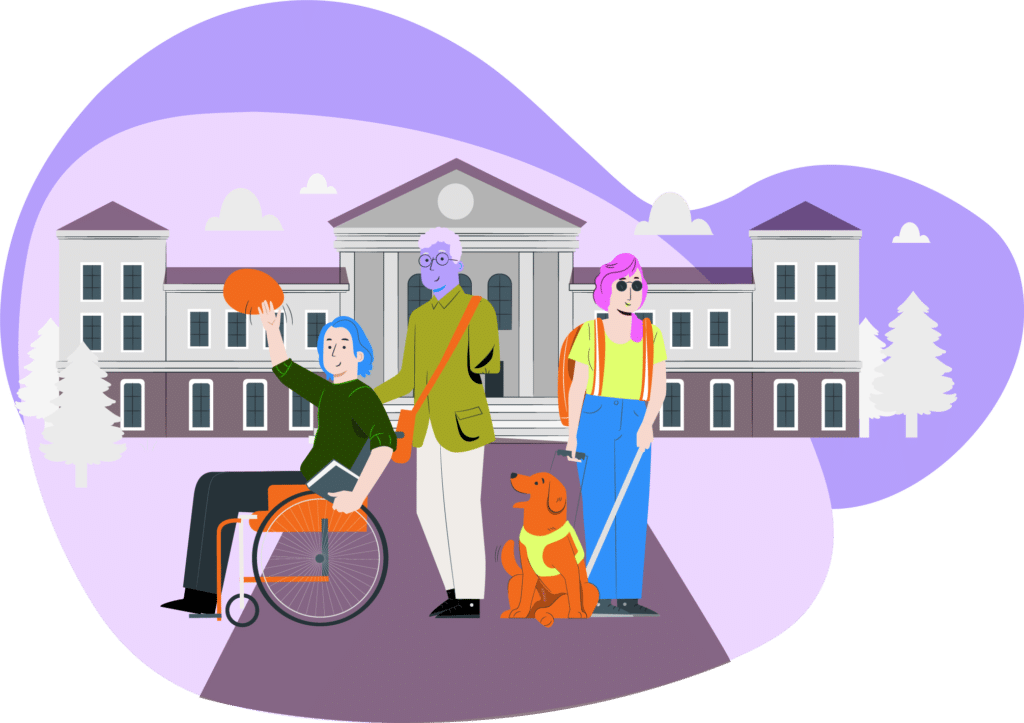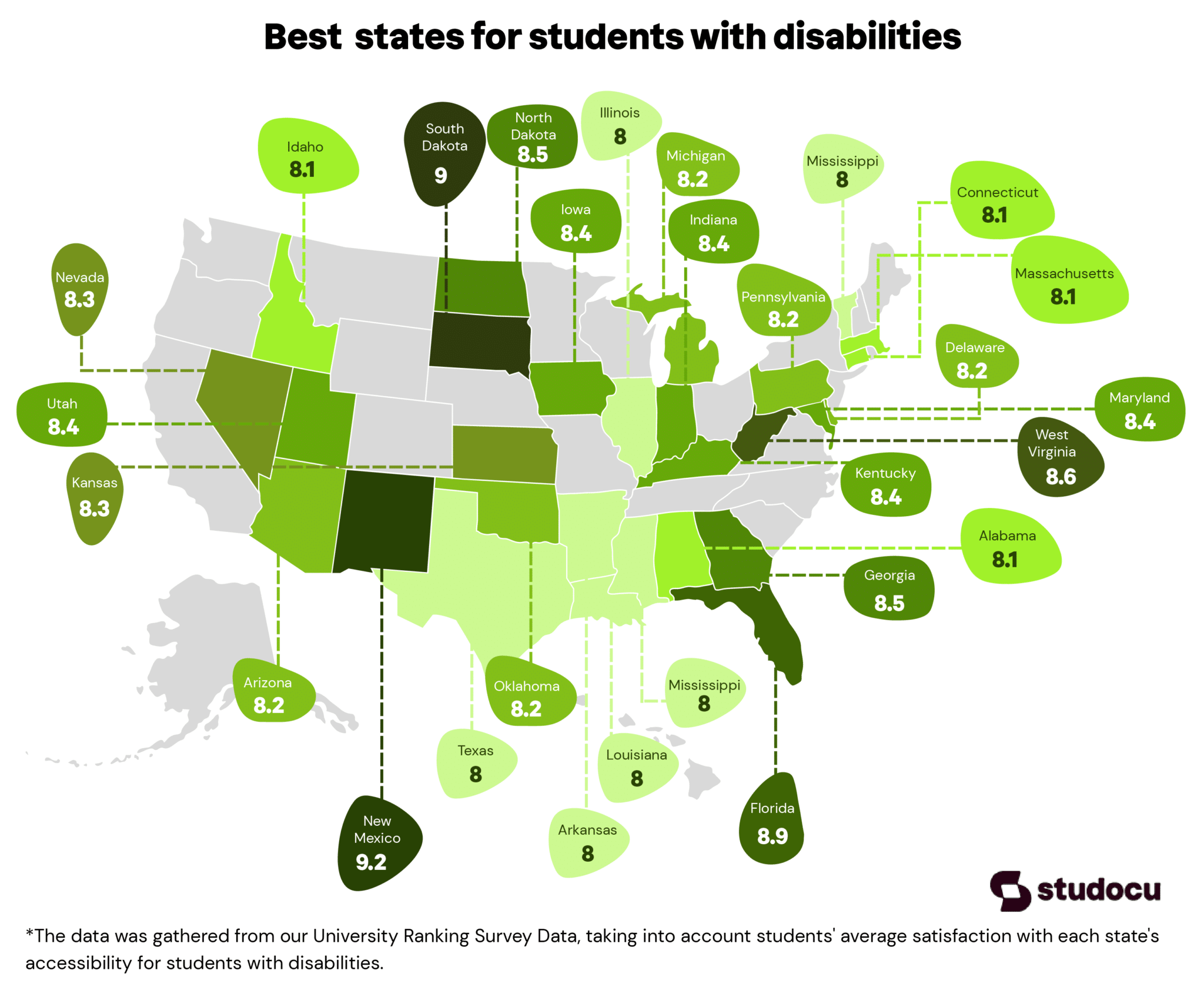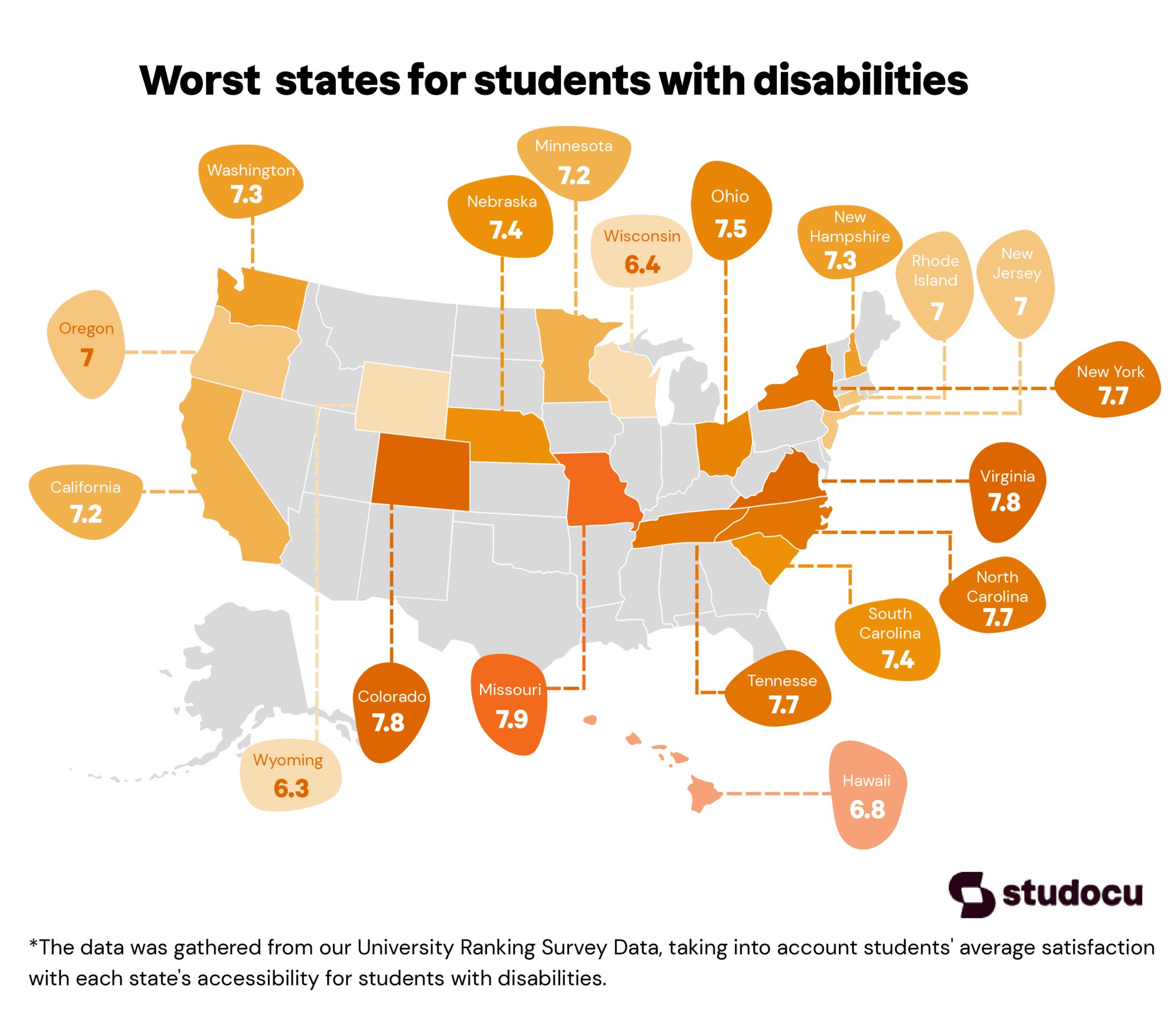Best and Worst Cities for Students with Disabilities


Students with disabilities (SWD) are entering higher education in great numbers throughout the United States. According to the National Center for Education Statistics (NCES), in 2021, 7.2 million students – or 15% of students in public schools – served under IDEA (Individuals with Disabilities Education Act), marking an increase from the previous year.
Like any student entering a new learning environment, some experience transitional challenges; for many young adults it is their first time away from home, their first experience with independence, or their first encounter with a new academic and social environment. However, college SWD face additional barriers and difficulties that can hinder their academic success.
With the physical and economic challenges of managing a disability in mind, Studocu went through the data comparing more than 350 cities across the US to find the most disability-friendly ones. Our data set ranges from the cost of living to the average income for people with disabilities and much more. Before delving into the best and worst cities for disabled students, the research team at Studocu decided to look at the bigger picture and see the best and worst states for students with disabilities in the US based on accessibility.

Key Takeaways
- According to our findings, Youngstown, Ohio, ranked as the best city for students with disabilities, whereas Passaic, New Jersey, ranked as the worst.
- The city of Sunnyvale topped the list for the highest median income for people with disabilities at $85,360, followed by Pleasanton at $83,500 and Bellevue at $76,300.
- Bloomington and Indiana are among the cities with the lowest median income at $14,360, followed by Ames, Iowa, at $14,908, and Provo, Utah, at $15,115.
- Youngstown, Decatur, Akron, and Flint topped our list with the lowest cost of living for affordable housing and living expenses, while Sunnyvale, Redwood, Berkeley, and Pleasanton were at the bottom with the highest cost of living in the country.
- Our original data shows that the best state for student accessibility is New Mexico, with a total rate of 9.2 out of 10, followed closely by South Dakota (9/10) and Florida (8.9/10).
- The three states that topped our list of worst states for students with disabilities are Wyoming, Wisconsin, and Hawaii, with a rating of 6.3, 6.4, and 6.8, respectively.
Top 10 Best and Worst States for Students with Disabilities
The Americans with Disabilities Act (ADA) is a legal protection form for people with disabilities. ADA makes it illegal to discriminate against people with disabilities in any area of public life, such as work, business, school, transportation, and all other places open to the public.
For instance, accessibility in universities is crucial in ensuring that students with disabilities have equal opportunities to learn and succeed, promoting inclusivity, meeting legal requirements, and preparing students for the workforce. But, while regulations like ADA require that all US states grant accessibility to the general public, the legal result varies from place to place. Our original data shows that the best state for student accessibility is New Mexico, with a total rate of 9.2 out of 10, followed closely by South Dakota (9/10) and Florida (8.9/10).

It’s important to note that accessibility for students with disabilities can vary significantly within a city and depend on individual circumstances. However, data shows that some cities in the US may present more challenges for students with disabilities than others. The three states that topped our list of worst states for students with disabilities are Wyoming, Wisconsin, and Hawaii, with a rating of 6.3, 6.4, and 6.8, respectively.

Best and Worst Cities for Students with Disabilities
As students with disabilities strive to achieve academic success, the city they choose to pursue their education in can play a crucial role in their experience. While some cities offer a range of support services, accommodations, and accessibility options that cater to the needs of disabled students, others may fall short in these areas, making it challenging for disabled students to thrive.
Therefore, it’s essential to identify the best and worst cities for students with disabilities to help them make informed choices. In the best cities, disabled students can find a supportive environment that promotes inclusion, accessibility, and equal opportunities for all. In contrast, in the worst cities, disabled students may face significant challenges, including discrimination, lack of accessibility, and inadequate support.
We explored the best and worst cities for students with disabilities to be able to provide valuable insights for disabled students seeking to make informed decisions about their education.
Median income for people with disabilities
Students with disabilities strive to navigate the workplace, but they often face challenges that can make it difficult to secure stable employment and earn a livable wage. Income is a crucial aspect of economic stability, and the median income of disabled workers can vary significantly depending on the city they reside in: some cities in the United States have made strides in supporting people with disabilities in the workforce, providing accessible jobs, and offering equal opportunities, while others have not.
Cities with the highest median income for people with disabilities
The list below represents the ten United States cities with the highest median income for people with disabilities, according to the U.S. Census Bureau’s American Community Survey data. The city of Sunnyvale tops the list at $85,360, followed by Pleasanton at $83,500 and Bellevue at $76,300.
It’s worth noting that these cities offer various job opportunities, support services, and accessibility options that make it easier for people with disabilities to find a job and make a living. For instance, Sunnyvale and Milpitas are both located in Silicon Valley, a region known for its high-tech industry and high-paying jobs, which may explain their high median income figures for people with disabilities. Meanwhile, cities like Folsom and Plymouth offer lower living costs, which can help individuals stretch their income further.
Cities with the lowest median income for people with disabilities
The ten cities below have a lower median income for people with disabilities compared to other cities in the country, with Bloomington, Indiana, having the lowest median income at $14,360, followed by Ames, Iowa, at $14,908 and Provo, Utah, at $15,115.
Several factors contribute to the lower median income figures in these cities. For instance, some have a limited job market, particularly for individuals with disabilities, which can result in fewer job opportunities and lower wages. In addition, some of these cities have a higher cost of living, which can further exacerbate economic challenges.
Cities with the lowest median income for people with disabilities
Cost of living
The cost of living reflects the income required to maintain a certain standard of living, including housing, transportation, food, and healthcare expenses.
For students with disabilities, the cost of living can significantly impact their ability to access education and support services. Cities with a higher cost of living may have higher housing costs, making it more difficult for students with disabilities to secure accessible and affordable housing. Additionally, higher transportation, food, and healthcare costs can further strain students’ financial resources, making accessing necessary support services and accommodations more challenging.
Cities with the lowest cost of living

*Cost of living indices are based on a US average of 100. Figures above or below the average represent a city as more expensive or less expensive.
The cities with the highest cost of living, such as Sunnyvale, Redwood, Berkeley, and Pleasanton, are all located in California, which has some of the country’s highest housing and healthcare costs. However, these cities also offer various job opportunities, support services, and accessibility options that can benefit students with disabilities.
For instance, they may have more accessible transportation options, such as public transit or paratransit services, or more inclusive workplaces that offer accommodations and support services. On the other hand, the cities with the lowest cost of living, such as Youngstown, Decatur, Akron, and Flint, offer more affordable housing and living expenses. However, these cities may also have a more limited job market and fewer support services for students with disabilities, making it challenging to access education and employment opportunities.

Cities with the highest cost of living
*Cost of living index is based on a US average of 100. Figures above or below the average represent a city as more expensive or cheaper.
Closing Thoughts
Finding the best city to live in as a student with disabilities can provide a foundation for success. To be able to thrive academically, socially, and personally, students with disabilities will need a safe and accessible environment, access to resources, and a welcoming community. All these factors contribute to a sense of belonging and well-being.
Hopefully, this study can help students identify cities that meet their needs and preferences. Nonetheless, it’s also important to visit the city and explore its resources and community in person before making a decision.
Methodology
To decide on the most livable places for people with disabilities, Studocu compared 395 cities across three key dimensions:
1) Median income of disabled people
2) Cost of living
3) Percentage of people with disabilities
Each metric was graded on a 100-point scale, with a score of 100 representing the most favorable conditions for students with disabilities. Ultimately, we determined each city’s overall score by adding all the dimensions and calculating the average score. We used the final scores to rank our sample.
Regarding the best and worst states for students with disabilities, we used our University Ranking Survey Data with more than 72,000 respondents at more than 1,300 universities across 28 countries. To determine the best and worst states, we took into account students’ average satisfaction on ‘Accessibility for Disabled Students’ for each state.
About
Studocu is a website that allows students worldwide to exchange study documents and strive for better academic outcomes. Their mission is to empower everyone to excel at their studies and in life by providing the best tools to study more efficiently.
Currently, over 26 million high-quality study documents have been shared by more than 15 million students who use Studocu. These documents are accessible to everyone interested in studying and practicing thousands of subjects.
Media Contact
press@studocu.com
